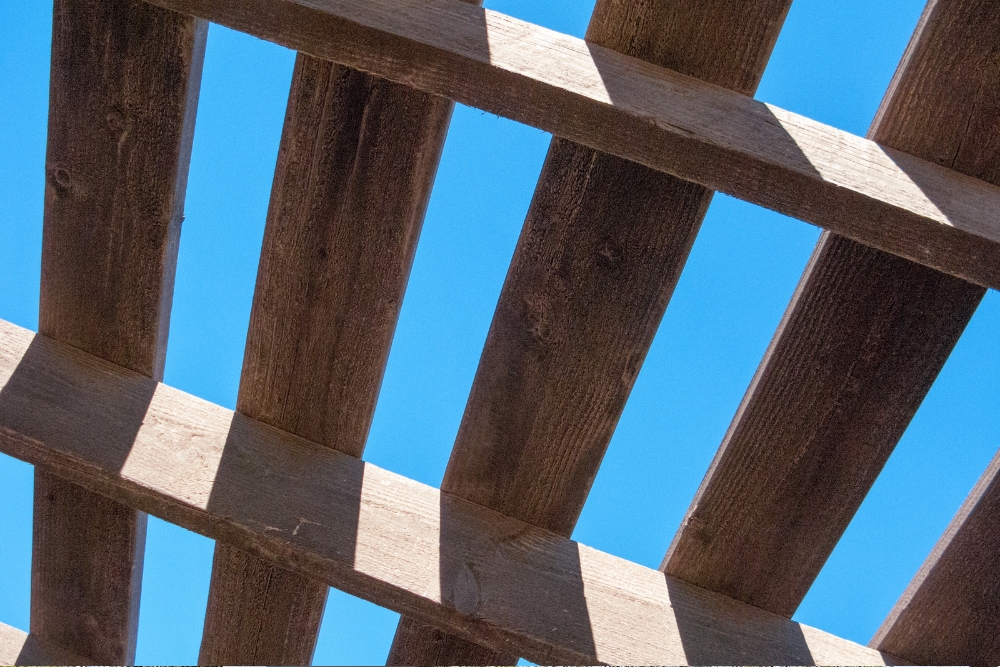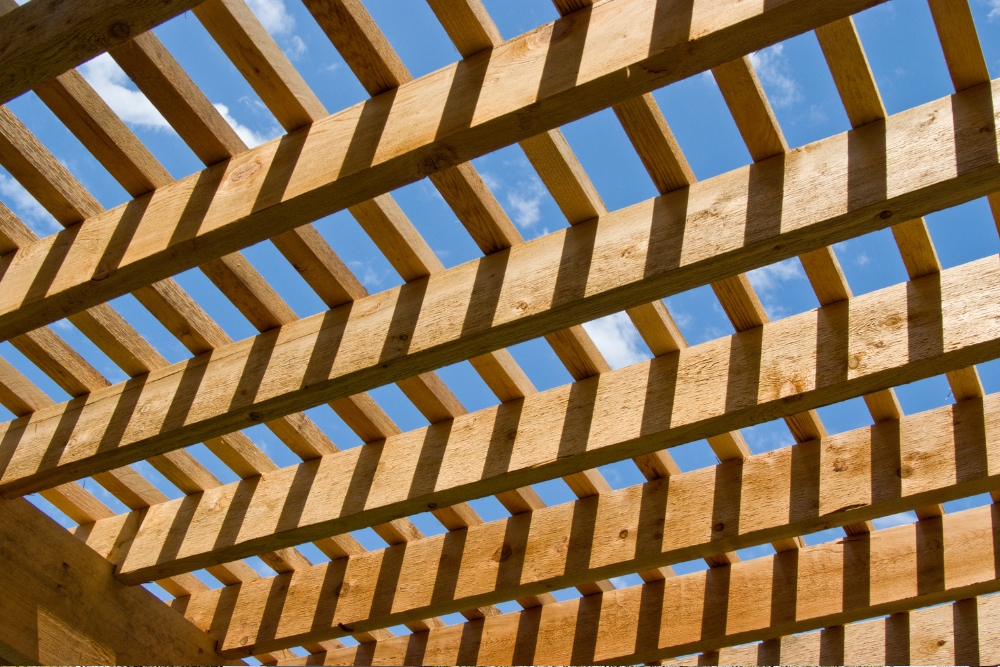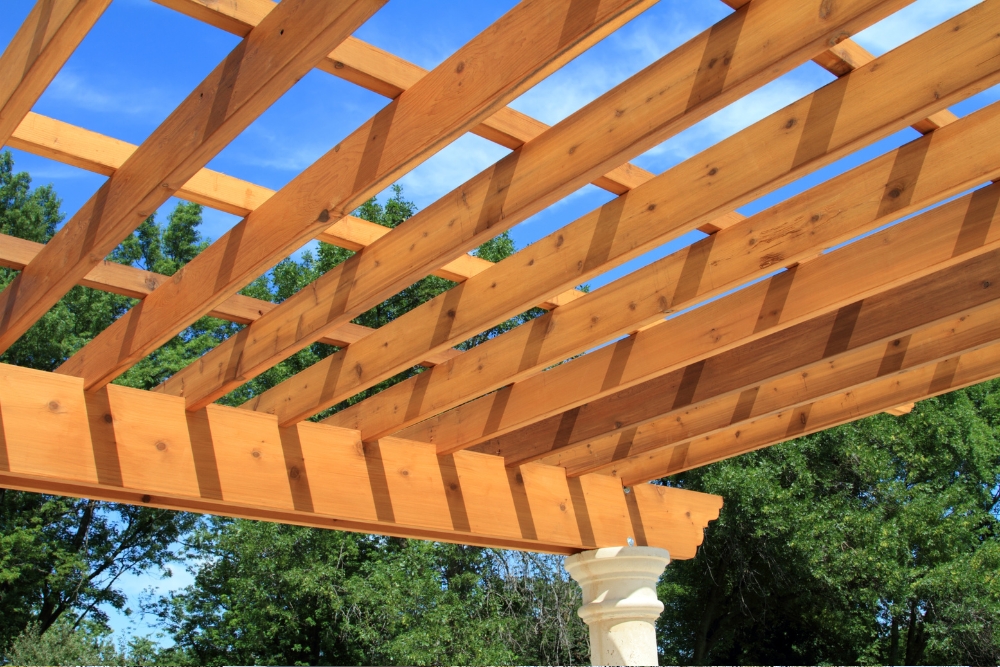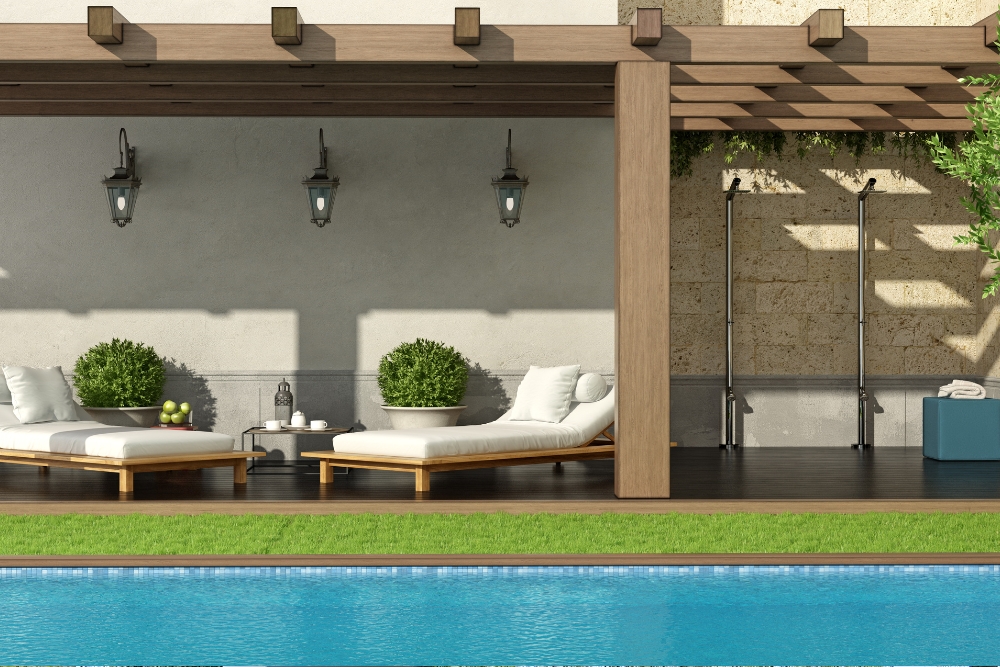Ever wandered through your backyard and felt like it lacked a certain ‘je ne sais quoi’ as you ambled amongst the greenery? You’re not alone, mate. We’ve all had that moment where our outdoor space feels just a smidge incomplete.
After having a good chinwag with some top-notch landscape aficionados, we stumbled upon a ripper of an idea: wooden pergolas. They’re not just for looks; these beauties can change the whole vibe of your garden stroll, making it feel like less of a walk and more of an experience—a fusion of function and sophistication if you will.
Key Takeaways
- Wooden pergolas transform garden pathways into inviting walkways, offering shade and a touch of elegance to the landscape.
- They come in two main types: attached pergolas, which extend living space from a home, and freestanding pergolas for flexibility in garden design.
- Climbing plants such as honeysuckle or clematis can be trained on pergolas to create natural canopies that enhance backyard beauty with vibrant greens and florals.
- Pergolas add visual appeal and functionality to outdoor spaces by providing areas for relaxation or entertainment while sheltering from sun exposure.
- Combining a pergola with trellises or arbours creates an attractive entryway into your garden and increases the overall charm of your outdoor living areas.

Definition and Purpose of Pergolas
A pergola is a structure that can be attached to a building or freestanding in the garden, providing a shaded walkway, passageway, or sitting area. It not only enhances the aesthetics of outdoor spaces but also adds functionality by offering shade and privacy.
Types of pergolas (attached, freestanding)
Pergolas are outdoor timber frameworks that can transform our garden pathways into inviting walkways. We love them for their versatility and the touch of elegance they bring to any landscape.
- Attached Pergolas: These structures are great for extending our living space outdoors, as they attach directly to our home. They create a seamless transition from inside to outside, providing shade right by the house. This type is particularly suitable for those of us looking to cover patios or decks while still maintaining a connection with indoor areas.
- Freestanding Pergolas: For those seeking an oasis in the middle of their garden, freestanding pergolas are ideal. We can place them anywhere we desire in our landscape design – over garden walkways, as a central feature in our yard, or even as a standalone structure offering shade and privacy anywhere in the outdoor space. Their independent placement gives us flexibility in design and function.
Benefits of a Wooden Pergola
Wooden pergolas offer a range of benefits for homeowners looking to enhance their outdoor spaces. The natural timber construction provides a charming and elegant touch, adding visual appeal to garden pathways while creating inviting walkways in the landscape.
Beyond aesthetics, wooden pergolas also serve as practical structures, offering shade and shelter from the searing summer heat, making them a valuable addition to any backyard. Additionally, with proper planting and maintenance, climbing plants like honeysuckle and clematis can be trained to grow over wooden pergolas, forming a beautiful natural canopy that enhances the outdoor ambience.
In terms of versatility, there are countless styles and uses for wooden pergolas – whether they’re used as walkways sitting areas or even as support for climbing plants in the garden.
Enhancing Outdoor Spaces with Pergolas
Adding shade and privacy to your outdoor space is essential for creating a comfortable and inviting environment. A wooden pergola can provide both, while also serving as a stunning focal point in your garden design.
Furthermore, by incorporating climbing vines into the pergola’s structure, you can create a beautiful green tunnel that adds depth and natural beauty to your landscape.
Adding shade and privacy
Wooden pergolas are an excellent addition to outdoor spaces, providing shade and privacy for your garden. The open roof or latticework of a pergola allows dappled sunlight to filter through, creating a comfortable and inviting space while still offering protection from the harsh sun.
This makes them perfect for enjoying leisurely afternoons outdoors without worrying about excessive exposure to direct sunlight. With climbing plants like honeysuckle and clematis trained over the wooden structure, you can create a natural green canopy that enhances privacy and adds a touch of tranquillity to your garden sanctuary.
Pergolas not only offer shade but also define an inviting area in your landscape where you can relax or entertain guests. They add character and charm to any yard, creating an intimate atmosphere ideal for spending quality time with family and friends.
Creating a green tunnel with a pergola and vines
Vines cascading over a wooden pergola can transform your garden path into a lush, enchanting green tunnel. Choosing climbing plants such as honeysuckle and clematis allows you to create a natural canopy that provides shade and adds a touch of whimsical beauty to your outdoor space.
As the vines intertwine with the structure, they form an inviting walkway that complements the aesthetic of your landscape.
By incorporating vines into your pergola design, you can achieve a picturesque setting where nature and architecture seamlessly blend. The result is an alluring pathway that beckons you to wander through your garden, enveloped by verdant foliage and dappled sunlight filtering through the intertwined vines.
Incorporating Vines into Pergola Design
Adding vines to your pergola design can enhance the aesthetic appeal of your outdoor space, creating a green and lush environment. Choosing the right climbing plants, proper planting and maintenance, as well as training vines on the pergola structure are all essential aspects to consider for a successful garden pathway with pergolas.

Choosing the right climbing plants (honeysuckle, clematis)
To cover your pergola with the right climbing plants, it’s essential to consider the climate and the specific needs of the plants. Here’s how you can choose the right climbing plants for your wooden pergola:
- Select climbing plants that thrive in your local climate and soil conditions to ensure their health and longevity. Consider factors like sunlight exposure, water requirements, and seasonal changes.
- Evaluate the growth pattern of each plant to determine its suitability for covering a pergola. Some plants may grow rapidly and require regular maintenance, while others may provide a more controlled and manageable growth.
- Research the flowering seasons of honeysuckle and clematis to create a blossoming display throughout different times of the year, enhancing the visual appeal of your pergola.
- Ensure that the chosen climbing plants are not invasive species that could potentially harm other garden vegetation or spread uncontrollably in your landscape.
- Consider fragrant varieties of climbing plants such as honeysuckle to add a delightful aroma to your outdoor space, enhancing the sensory experience within your garden.
Proper planting and maintenance
To ensure your climbing plants thrive on your wooden pergola, follow these steps:
- Choose the right climbing plants such as honeysuckle or clematis, considering their growth habits and sunlight needs.
- Plant them at the base of the pergola in well-draining soil that is rich in organic matter to promote healthy growth.
- Install a secure trellis system to support vine growth and prevent damage to the pergola structure.
- Regularly prune and train the vines to encourage upward growth and prevent overgrowth or entanglement with other plants.
- Water the climbing plants regularly, especially during dry periods, to keep the soil consistently moist but not waterlogged.
- Apply a balanced fertiliser to provide the necessary nutrients for vigorous vine growth and abundant flowering.
Tips for training vines on pergola structures
To train vines on pergola structures, choose climbing plants like honeysuckle or clematis, which can create a beautiful natural canopy. Here are some tips to help you train the vines effectively:
- Select strong and healthy young vines for planting on your wooden pergola.
- Plant the vines at the base of the pergola’s columns or trellis, ensuring they have enough space to spread and grow.
- Provide regular watering to encourage healthy growth and establish a strong root system.
- Guide the vines towards the pergola structure by gently tying them with soft garden twine or plant ties.
- Prune the vines regularly to remove any dead or damaged growth and shape them as they grow across the pergola.
- Train the vines to cover the entire pergola structure evenly, creating a lush green tunnel effect over time.
Creative Ideas for Garden Pathways with Pergolas
Add a unique touch to your garden pathways by incorporating a pergola as a walkway feature. Combine the beauty of a pergola with a trellis or arbour for an inviting and charming entryway to your outdoor space.
Adding a pergola as a walkway feature
Enhance your garden pathway with a beautiful wooden pergola, creating an inviting and stylish walkway through your landscape. A timber pergola can add charm and elegance to any garden design, providing structure while blending seamlessly with natural surroundings.
By carefully placing the pergola along your garden path, you can create a defined walkway that is both functional and visually appealing. Incorporating climbing plants such as honeysuckles or clematis onto the pergola will further enhance the beauty of the walkway, adding a touch of nature as you stroll through your outdoor space.
Transforming your garden paths into stunning walkways with the addition of a pergola provides an opportunity to elevate the aesthetic appeal of your landscape while offering practical benefits.
The placement and design possibilities are endless, allowing for creativity in personalising this feature to suit individual tastes and styles.
Combining with a trellis or arbor
Incorporating a trellis or arbour into your garden pathway design can complement the charm of a pergola. The combination of these structures creates a seamless flow, adding visual interest and enhancing the overall appeal of your outdoor space.
A well-placed trellis adorned with climbing plants can accentuate the elegance of a wooden pergola while an arbour integrated along the pathway offers a picturesque entrance, inviting guests to explore your landscaped haven.
By intertwining vines from the pergola onto the trellis or arbour, you can create a cohesive and enchanting natural tunnel effect that adds an extra layer of beauty to your garden pathways.
This fusion not only elevates aesthetics but also provides shade and shelter, making it an attractive feature for homeowners seeking both style and functionality in their landscape designs.

Buying or Building a Pergola
When it comes to buying or building a pergola, there are a few important factors to consider. From cost comparison between buying and DIY to choosing the right materials and design, it’s essential to weigh your options carefully.
Whether you decide to take on the challenge of a DIY project or hire a professional, investing in a wooden pergola can enhance your outdoor space and add value to your home.
Cost Comparison
As we consider adding a pergola to our garden pathways, it’s essential to understand the cost differences between buying a ready-made kit, having a custom design built, or taking on a DIY project. Here’s a quick comparison to help us decide the best option for our budget:
| Option | Approximate Cost | Pros | Cons |
|---|---|---|---|
| Ready-Made Kit | $1,000 – $3,000 | Convenient, quicker installation | Less customisation |
| Custom Built | $5,000 – $10,000+ | Fully customisable, professional finish | Higher cost, longer installation time |
| DIY Project | $500 – $2,000 | Cost-effective, personal satisfaction | Time-consuming, requires skill |
We need to factor in the cost of materials, design, and labour if we’re not building the pergola ourselves. A DIY approach can save us money, but we must feel confident in our carpentry skills. On the other hand, purchasing a ready-made kit or hiring professionals offers convenience and potentially a more polished look but at a higher cost. Our choice will depend on the balance we wish to strike between budget, time, and customisation.
DIY vs. hiring a professional
Building a wooden pergola yourself can save money, but it requires time and effort. Constructing a DIY pergola allows for customisation to fit your specific needs and design preferences. Alternatively, hiring a professional ensures expertise in construction and avoids the challenges of sourcing materials and navigating complex designs. Professional builders bring experience to the table, simplifying the process while guaranteeing high-quality results that align with your vision.
If you decide on a DIY approach, consider researching suitable materials along with region-specific building codes to ensure structural integrity. On the other hand, working with a professional provides peace of mind regarding permits and adhering to local regulations while allowing for timely completion without sacrificing quality craftsmanship. Both options offer distinct advantages depending on your budget, available time, and level of project involvement.
Important factors to consider when choosing materials and design
When deciding between DIY construction or hiring a professional for your pergola, you should keep in mind the following factors when choosing materials and design:
- Location and climate play a crucial role in selecting suitable materials. Ensure the chosen material can withstand weather conditions, such as rain, wind, and sun exposure.
- Consider the maintenance requirements of different materials to ensure long-term durability and aesthetics in your outdoor space.
- Incorporate your personal style and preferences into the design to complement your existing landscape and the overall aesthetic of your property.
- Pay attention to the size and scale of the pergola to ensure it fits harmoniously within your garden or backyard space without overwhelming other features.
- Research local building codes or homeowners’ association regulations to adhere to any restrictions on materials or design elements for your pergola project.
- Evaluate the cost-effectiveness of different materials while keeping quality and longevity in mind for a sustainable investment in your outdoor living space.
- Seek professional advice from landscape architects or experienced builders to guide you through material options, design considerations, and construction methods based on your specific requirements.
- Take time to explore various design inspirations that align with the function of your pergola, whether it’s serving as a walkway feature or an inviting seating area within your landscape.
Aluminum Pergolas: Define Your Space with Elegance!
Incorporate a wooden pergola to enhance your garden pathways. Consider adding climbing plants like honeysuckle or clematis for a natural canopy. Customise your pergola to add elegance and charm to your landscape.
Explore the versatility and practicality of wooden pergolas in creating inviting walkways in your garden.
Enhance the beauty of your garden landscape with Wooden Pergolas for garden paths! Create inviting walkways that weave through your lush surroundings, offering a picturesque journey through nature’s beauty. Elevate your outdoor experience with charming Wooden Pergolas, transforming your garden paths into enchanting passages of tranquillity and elegance. Contact Us Today!




